

 Vol. 39 (Nº 01) Year 2018. Page 27
Vol. 39 (Nº 01) Year 2018. Page 27
Sofia N. ALAEVA 1; Аleksey V. ANTYUFEEV 2; Sergey A. BOLGOV 3; Ivan I. SOKOLOV 4
Received: 28/08/2017 • Approved: 03/10/2017
2. Natural Parks of Volgograd Oblast
3. Shcherbakovsky Natural Park
ABSTRACT: The article is devoted to the city-planning analysis of Shcherbakovsky natural park. The strategy of the natural park’s transformation should be based on targeted increase of natural components with formation of ecological frame. The schemes for zoning of natural landmarks with determination of zone limits are developed, in view of inhomogeneity of the territory for the following factors: character of city-planning development and natural conditions. Based on the functional zoning scheme, the authors have compiled a system of recreational entity, with distinguishing the most protected natural landmarks. |
RESUMEN: El artículo está dedicado al análisis urbanístico del parque natural Shcherbakovsky. La estrategia de la transformación del parque natural debe basarse en un crecimiento específico de componentes naturales con la formación de un marco ecológico. A los efectos de la planificación urbana y las condiciones naturales, los límites espaciales del área se determinan en términos de la falta de homogeneidad del territorio para los siguientes factores: Con base en el esquema de zonificación funcional, los autores han compilado un sistema de entidades recreativas, distinguiendo los hitos naturales más protegidos. |
It is well-known that natural parks preserve the uniqueness of nature’s creations. They are peculiar for their picturesqueness. Their uniqueness corresponds to the national significance of these territories. It attracts a lot of visitors [4].
First national parks appeared in the age of industry and unlimited use of natural resources. Their creator tried to preserve the most unique and rare corners of nature from destructive influence of technology.
Over the recent times, Volgograd agglomeration has suffered significance changes of planning development.
At the beginning of the 21st century, Volgograd Oblast has six natural parks. However, these parks were never realized in reality, for they are developed very slowly. Unfortunately, the set perspectives of city-planning development of natural parks were not sufficiently finance by the Oblast authorities and by the state. Small planning areas were created without consideration of the whole territory of the natural park. As a result, a lot of various zones emerged, which are still visited by the population. At a certain time, natural parks were not renewed.
Natural parks are relatively new specially protected territories – as a rule, they cover the lands that are given to them in unlimited use [5].
Natural parks – together with natural landscape – consist of areas of cultural, mainly agricultural, landscape, sometimes village with peculiar architecture. On the territory of the natural park, agricultural activities are not excluded, but it should be conducted so as not to change the landscape features of the territory [2, p. 160].
A natural park consists of several functional zones: nature protection, buffer, recreational, and agricultural [6]. This article views the issues of zoning of the territory and the system of recreational entity with distinguishing specially protected natural landmarks.
At present, Shcherbakovsky natural parks has to solve a lot of issues, the main of which concerns the depth of knowledge of relations between the visitors and the nature – for not only their recreation, but protection of nature and prevention of its “degradation”.
Natural parks include not only the most picturesque areas peculiar for their historical, prehistorical or scientific interest. They vary from very small to areas of several hectares [7].
Volgograd Oblast has seven natural parks: Volga-Akhtuba bottom land, Don, Nizhnekhopersky, Ust-Medveditsky, and Tsimlyansky sands, and Shcherbakovsky and Eltonsky natural park. According to their significance, they are divided into national (state), regional, and local.
Table 1
Areas of protected natural territories in Volgograd Oblast.
Natural park |
Area of protected territories |
||
m², thousand |
% of country’s territory |
% of territory of Volgograd Oblast |
|
Volga-Akhtuba bottom land |
1,538 |
0.009 |
1.35 |
Don |
619 |
0.004 |
0.54 |
Nizhnekhopersky |
2,312 |
0.014 |
2.03 |
Ust-Medveditsky |
512 |
0.003 |
0.45 |
Tsimlyansky sands |
690 |
0.004 |
0.61 |
Shcherbakovsky |
346 |
0.002 |
0.31 |
Eltonsky |
1,060 |
0.006 |
0.93 |
-----
Table 2
General data on natural parks of Volgograd Oblast
No. |
Name of the natural park |
Location (district) |
Area, km² (hectares) |
Date of creation |
1 |
Volga-Akhtuba bottom land |
Leninsky, Svetloyarsky, Sredneakhtubinsky |
1,538 (153,800) |
May 6, 2000 |
2 |
Don |
Ilovlinsky |
619 (61,900) |
September 25, 2001 |
3 |
Nizhnekhopersky |
Aleekseevsky, Kumylzhensky, Nekhaevsky |
2,312 (231,200) |
May 7, 2002 |
4 |
Ust-Medveditsky |
Serafimochsky |
512 (51,200) |
June 24, 2004 |
5 |
Tsimlyansky sands |
Chernyshkovsky |
690 (69,000) |
June 4, 2003 |
6 |
Shcherbakovsky |
Kamyshensky |
346 (34,600) |
June 4, 2003 |
6 |
Eltonsky |
Palassovsky |
1,060 (106,000) |
September 25, 2001 |
Volga-Akhtuba bottom land has a large ecological, esthetic, and historical & cultural value. It belongs to the first category of international importance and plays the role of regulator for atmosphere air in Low Volga region (Volgograd, Volzhsky, and Astrakhan). The most important values of the bottom land region are key ornithological territories and swamplands.
Organization of the part was caused by the need for preservation of the unique natural and historical & cultural complexes. Leshevsky state hunting reserve is located on the territory of the park [8].
International status: Key ornithological territory of international significance VG-012 “Akhtuba Lake Region”.
Don natural park is a natural complex located in the Small curve of the Don River. It is a spot of the largest approach of two rivers – the Volga and the Don. Don park has a lot of unique natural complexes and objects:
It is a reserve for many plants and animals from the Red Book. Some birds under the danger of extinction live on the territory of the park.
Due to excellent climate, the natural park is a nice recreational area, attracting a lot of tourists.
There are several objects and factors that negatively influence the natural landmarks and complexes of the park:
For development of conditions on the territory of Don natural park, the set rules of nature use and the protection system are improved. Also, some of the specially protected nature complexes are restored on the whole territory of the park.
Don natural park was assigned international importance. All its territory belongs to the key ornithological territory “Kalach curve of the Don”.
Nizhnekhopersky natural park, which was organized for the purpose of preserving natural and cultural values, is located on the territory of three administrative regions. The main natural landmarks are the following:
Nature complexes that are parts of the park have a large historical & cultural and nature protection value. Rare and endangered types of plants and animals, as well as low population density, increase ecological value of the territory.
Among large diversity of flora and fauna, there are a lot of rare types from the Red Book of Volgograd Oblast.
Ust-Medveditsky natural park combines diversity and contrast of natural conditions with rich inheritance of material and spiritual culture of peoples. Bottomland and ravine forests located along the rivers Don, Medveditsa, and Protoka are the main landmarks of the natural park.
Diversity of reliefs and view and uniqueness of geological construction predetermine presence of unique landscape complexes with their own micro-climate, flora, and fauna.
The park was created for the purpose of preserving the unique nature complexes and supporting ecological balance under the conditions of recreational use of natural resources [10].
Tsimlyansky sands is a natural park with large bays of the Tsimliansky water reserve, which are the main breeding grounds for valuable fish, most of which are in the Red Book. The natural park was organized for the purpose of preservation of a large area which reflects all types of landscape. Low population density predetermines high ecological significance.
The park is divided into several functional areas:
As to its features, Shcherbakovsky park is one of the most interesting parks; it consists of various combinations of natural complexes and objects, which makes it unique. Apart from rocks, an important role in development of relief and landscape belongs to underground waters.
Apart from diverse flora and fauna, the natural park Shcherbakovsky has historical value. It consists in the fact that the park is a place of traditional settlement of Volga Germans – colonizers with their original culture. As of now, a lot of cultural & historical objects are lost, but the phenomenon of “place memory”, related to a special model of people’s life, is preserved.
Natural landmarks:
Local reserves:
International status: Key ornithological territory of international importance VG-008 “Shcherbakovskaya Curve of Volga”.
Eltonsky natural part in a unique one. Elton – one of the most wonderful lakes in the world – is located in it; the lake is rich in salt and therapeutic muds. It is unique by its origin as is the largest solar salt lake in Europe.
The territory of the natural park is peculiar for diversity of landscapes and a lot of endangered species of plants and animals. Memory of the past preserves plenty of objects of cultural heritage and cultural traditions of many nomadic peoples and tribes.
“Natural park is a large area of natural and cultural landscapes, which is the least strict as compared to other types of natural protected territories, characterized by uniqueness and picturesqueness and fit for recreational use” [3, p. 121].
Shcherbakovsky is a natural park and a monument of nature. Uniqueness of its landscapes attracts a lot of visitors. It has a lot of natural landmarks.
One of its main goals is to preserve objects (features) of nature of national significance in the interests of enlightenment, science, and public recognition.
Presence of species and forms that are endangered makes this park a unique one.
Fig. 1
Scheme of Shcherbakovsky Natural Park
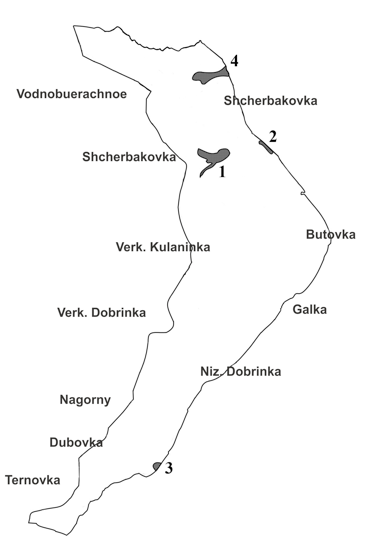
All natural landmarks in Shcherbakovsky park are unique and irreplaceable. They are examples of untouched nature.
One of the natural landmarks – “Krivtsovskaya Ravine” (Figure 2) – has magnificent views and rich history. In the 14th century, there was the Golden Horde settlement here, Ternovskoe Settlement – which is confirmed by coins and crockery of the Golden Horde. There is a unique monument of the Bronze Age - Ternovskoe site – nearby, and in the 19th century the Germans founded a beautiful garden here.
Figure 2
Krivtsovskaya Ravine view [13]
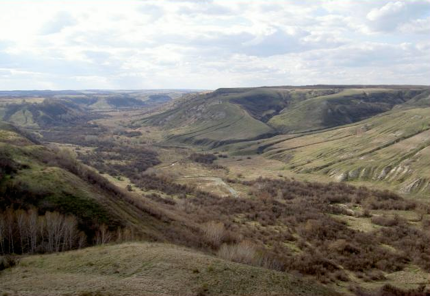
The most well-known location of the natural park is natural monument ироды Shcherbakovsky hollow (Figure 5); its age is about 50-60 million years, and depth of the ravine – 200 meters. Here flows the only mountain river of Volgograd Oblast - Shcherbakovka (Figure 4); due to its quick current, the air remains cool even in symmer. The hollow is a home to plants and animals from the Red Book.
Figure 3
Shcherbakovsky hollow [14]
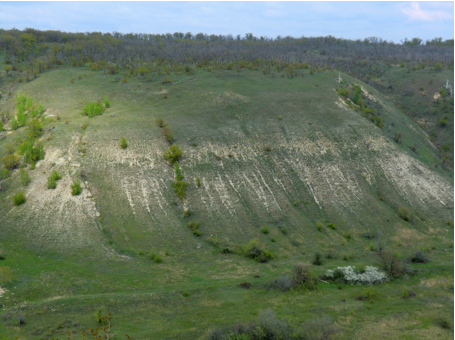
-----
Figure 4
The Shcherbakovka River [15]
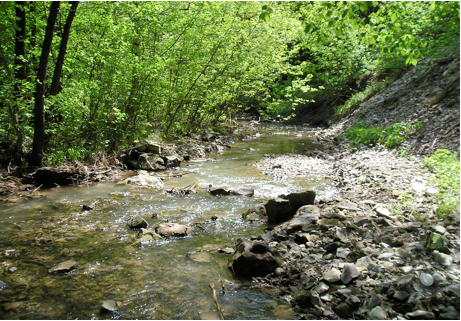
“Stolbichi” and Shcherbakovsky trap-down are natural and geological landmarks that appeared as a result of emergence of the Caspian Depression. “Stolbichi” is a yellow gray color, divided into ten large towers more than 80 meters high – these are the most bizzarre precipices along the whole Volga (Figure 5). The Northern boundary of Stolbichi features Shcherbakovsky trap-down. It is seen by the pack of gray sand clay of the Cretaceous period, 8 meters large.
Figure 5
Stolbichi [16]
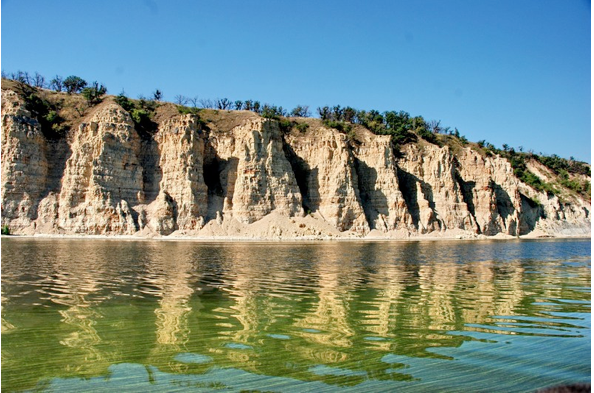
Another natural landmark, Urakov Hill is a very interesting site, known for the large number of artifical caves. Their origin is still unknown – from the historical point of view. Accodting to the legends, the Khan Urak lived here – a master of local lands. He was killed in a battle by Stepan Razin, a leader of Volga outlaws.
Figure 6
Urakov Hill [17]
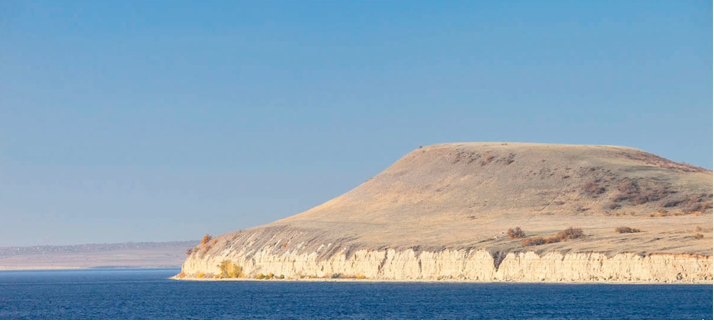
A natural park has the following purposes:
These purposes are achieved, and the interests of labor protection and recreation are combined due to territorial differentiation of one from another.
Natural park allows for fighting contradictions between recreation and protection of nature. The most important role during selection of a park among all recreational factors belongs to preservation of natural landscape; also, the activities leading to change of historical natural landscape, reduction or destruction of ecological, esthetic, or recreational qualities of natural parks, and violation of the regime of preservation of historical and cultural landmarks are prohibited.
The scheme with several reserves and replaceable zones of buffer protection and recreation is offered. With anthropogenic violation of the territory and presence of transport roads, the zoning picture becomes polycentric with local reserves.
Placement of special protection zones is subject to a sole feature – natural distribution of zones and objects of nature that deserve special protection. Their position starts creation of a zoning scheme.
Figure 7
Zoning of territory of Shcherbakovsky natural park
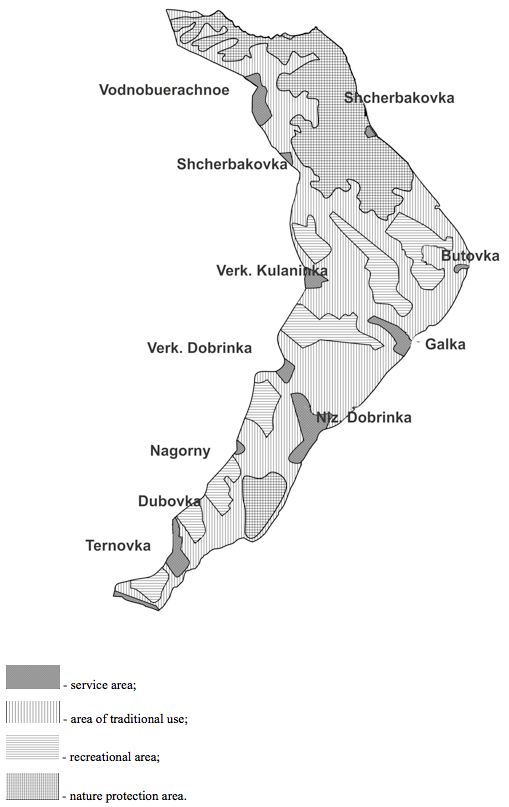
Such clear division is peculiar for a large diversity of economic & geographical, natural, and social conditions. As city-planning analysis shows, four main areas are sufficient in the conditions of Low Volga region.
One of the main factors during planning of a natural park is the use of existing settlements, towns, villages, communities, and farmsteads for recreational with involvement of all necessary natural conditions. Reconstruction and renovation of aged administrative and residential buildings in the picturesque sites of the park are also used. The existing networks of car, railroad, and waterway roads give investors large economic profit in view of protection of nature use.
Evaluating the complex character of modern formation of the country’s natural parks, it is necessary to note that together with popular parks, a lot of them are characterized with old city-planning approaches – they are not developed according to modern planning solutions.
Figure 8
Local reserves of the territory of Shcherbakovsky natural park
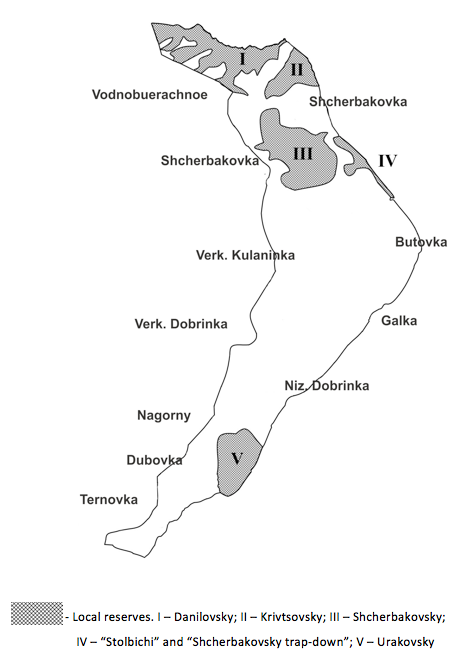
Natural parks could be resurrected by creating favorable conditions related to reconstruction of the city-planning direction of the system of natural parks in the Oblast. As a result of such approach, it if possible to form functional city-planning areas and objects for a large territory of natural parks. To change the current situation, it is expedient to distinguish five local cores in Shcherbakovsky natural park, related to perspective and planning stages of the development:
1st stage – forecast of planning development, containing the concept and spatial development of the park;
2nd stage – development of architectural and planning and landscape scheme of the natural park, which is at the stage of forecasting.
Such approach will allow for rationally substantiated direction of development of the park in the settlement system in the Oblast and Low Volga region, formation of modern mode of environment’s organization, activation of tourist ties, and creation of favorable recreational environment.
Zoning is not a mechanical process, but a result of the multifeature inventory of specific territory’s resources against the background of certain natural and economic environment of a larger region.
Conservation status and goals of a national park require limiting regimes of use and impose territorial or time bans for visits or actions.
The research was prepared with support from Volgograd State University of Architecture and Construction.
1. V.P. Strauskas. City-planning organization of sites and centers of recreation. SPb.:Stroyizdat, 1977. 164 p.
2. Large Soviet Encyclopedia / А.M. Prokhorov, Ed. by N.K. Baibakov, A.A. Blagonravov, V.K. Vasilenko, A.P. Vinogradod, V.V. Volsky, B.M. Vul, B.G. Gafurov, E.M. Zhukov, N.N. Inozemtsev, etc. 3rd edition. М.: Soviet Encyclopedia, 1975. 648 p.
3. Reymers N.F. Nature’s ABC. М.: Znanie, 1980. 208 p.
4. Zabelina N.M. National park. М.: Mysl, 1987.
5. Specially protected natural territories // Labor protection – Informational resource. 2004. URL: http://ohrana-bgd.ru/okrsrd/okrsrd3_19.html (Accessed: 14.05.2016).
6. Shcherbakovsky (natural park) // Wikipedia.URL: https://ru.wikipedia.org/wiki/Shcherbakovsky_(природный_парк) (Accessed: 14.04.2016).
7. "National Park." The Hutchinson Unabridged Encyclopedia with Atlas and Weather Guide. Abington: Helicon, 2015. Credo Reference. Web. 14 May 2016.
8. Volga-Akhtuba bottom land (natural park) // Wikipedia. URL: http://ru.wikipedia.org/?oldid=77607856 (Accessed: 24.04.2016).
9. Don (natural park) // Wikipedia. URL: http://ru.wikipedia.org/?oldid=78066187 (Accessed: 20.04.2016).
10. Natural park “Ust Medveditsky” // Serafimovich URL: http://www.serafimovich.org/priridniipark-um/138-prirodniipark.html (Accessed: 13.05.2016).
11. Decree of the Head of Administration of Volgograd Oblast dated December 21, 2009 No. 1614 “On establishment of a decree on Tsymlianskie Sands natural park” // Russian newspaper.
12. S.S. Ozhegov. History of landscape architecture. М.: Stroyizdat, 2004. 232 с.
13. Natural park “Shcherbakovsky” [E-source]// PPt4Web Hosting of presentations URL: ttp://ppt4web.ru/geografija/prirodnyjj-park-shherbakovskijj0.html (Accessed: 19.08.2016).
14. Tourism and travels [E-source]// Renault Duster Club (Russia) URL: http://www.dusterclubs.ru/vb/showthread.php?mode=hybrid&t=7563 (Accessed: 19.08.2016).
15. Natural park “Shcherbakovsky” [E-source]// Committee of natural resources and ecology of Volgograd Oblast URL: http://oblkompriroda.volganet.ru/other/photography/parks/shcherbakovskiy.php (Accessed: 16.08.2016).
16. Stolbichi [E-source ]// Where it is good URL: http://gdehorosho.ru/6885 (Accessed: 20.08.2016).
17. Deriabin V. Cruise along Volga Moscow-Astrakhan – Nizhny Novgorod on “Lev Tolstoy” [E-source] //Deriabino. URL: http://www.deryabino.ru/Volga/Volga-Osen-50/Volga-Osen-50.htm (Accessed: 20.08.2016).
1. Volgograd State Technical University, Volgograd, Russia; soffishka_33@mail.ru
2. Volgograd State Technical University, Volgograd, Russia; rosstroyproekt@mail.ru
3. Volgograd State Technical University, Volgograd, Russia; expertv@yandex.ru
4. Volgograd State Technical University, Volgograd, Russia; sokolov.ivan333@mail.ru